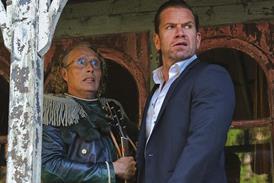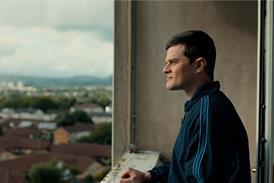
Dir:Jonathan Liebesman. US. 2008. 93mins.
Unremittingly gripping and unnerving, The Killing Room transforms a simple premise into a almost unbearably tense experience. As a departure from his gory 2006 remake of The Texas Chainsaw Massacre, director Jonathan Liebesman squeezes every little ounce of mind-game intrigue from the story of four strangers who sign up for a science experiment that turns out to be much more horrifying and deadly than they could have imagined.
Because The Killing Room involves luckless subjects forced to carry out the bizarre dictates of an unseen puppet-master, this thriller will undoubtedly draw comparisons to the Saw films, which feature an elaborate puzzle game that the victims must try to outsmart if they want to live. But unlike that horror franchise, The Killing Room mostly relies on psychological terror rather than blood and pain to produce its shocks. The film’s merciless treatment of its lab-rat characters will turn off some, but audiences who savour down-and-dirty genre thrills will find this darkly compelling.
Four volunteers (Cannon, DuVall, Hutton, Whigham) individually enter an almost-all-white room to take part in a paid scientific experiment. But once it becomes clear that Dr Phillips (Stormare), who is running the experiment, has fiendish intentions, the group must work together to keep from being killed one by one inside the room.
Though superficially similar to the Saw films, The Killing Room has a sickening elegance that’s entirely its own design. Working with cinematographer Lukas Ettlin, production designer Charisse Cardenas and composer Brian Tyler, director Jonathan Liebesman has constructed a claustrophobic, riveting thriller built almost entirely out of scenes of the volunteers trapped in a sealed white room debating how they can outsmart their captors as the threat of their deaths hangs in the air. The only minor relief from these desperate moments comes in conversations between Dr Phillips and a potential new protege named Emily (Sevigny) who had no idea that the doctor was involved in under-the-radar government experiments meant to test the limits of the human body. These conversations add an extra layer of suspense - Emily (and the audience) are watching the volunteers on a videotape, never sure if these horrific events have ended or are still going on.
On one level, Liebesman and screenwriters Gus Krieger and Ann Peacock are dealing with a wholly unrealistic scenario that could only occur in the movies - Phillips seems to always be one step ahead of his volunteers’ plans, and the film-makers’ explanation of the top-secret government facility is rather far-fetched. But The Killing Room asks for a suspension of disbelief in order for its psychological torments to fully disturb the audience, and the film’s brief running time helps maintain that hypnotic spell until the clever final twist.
It would be easy for the cast to resort to hyperventilating hysterics to create emotional effects, but the largely believable performances go a long way toward selling the movie’s nightmare scenario. Peter Stormare is ruthlessly clinical as the unscrupulous experimenter, while Timothy Hutton is commanding as the volunteers’ leader, capably playing an ordinary man forced into becoming extraordinary in the face of unspeakable dangers.
Production companies
Winchester Capital Partners
Film 360
Eleven Eleven Films
US sales
Creative Artists Agency
(1) 424 288 2000
International sales
Contentfilm International
(1) 310 576 1059
Producers
Ross M Dinerstein
Bobby Schwartz
Guymon Casady
Benjamin Forkner
Executive producers
Jonathan Liebesman
Ann Peacock
Jeff Sagansky
Jean-Luc De Fanti
Screenplay
Gus Krieger
Ann Peacock
Story by Gus Krieger
Cinematography
Lukas Ettlin
Production design
Charisse Cardenas
Editor
Sean Carter
Music
Brian Tyler
Main cast
Nick Cannon
Clea DuVall
Timothy Hutton
Chloe Sevigny
Peter Stormare
Shea Whigham















![[Clockwise from top left]: Paul Thomas Anderson, Chloe Zhao, Ryan Coogler, Park Chan-wook](https://d1nslcd7m2225b.cloudfront.net/Pictures/274x183/9/0/0/1467900_writerdirectors_192733.jpg)





No comments yet